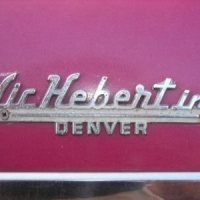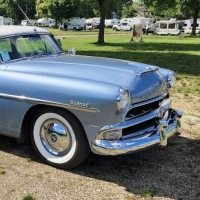Pertronix ignition vs WA-1 carburetors
My '54 died the other day. Testing indicated that either the coil or the pertronix module failed. The Pertronix had been in the car for about 10 years without any issues. Prior to the unit failure I had noticed that when the 308 was under moderate or higher load the engine started to "miss" frequently. It was doing this when the engine quit. It turned out that the Pertronix module had failed. I could have installed points but the small bracket on the side of the distributor needed to attach the condenser wire is long gone. So I purchased another Pertronix unit and installed it with a new coil, cap and rotor. It runs fine now except under-load the miss or cut-out is still occurring. Could it be that the WA-1s (twin-H) accelerator pumps are failing/dysfunctional? Could it be the pump adjustment rod (three settings)?
0
Comments
-
Spark plugs and secondary wires likely culprit.
Spray down the wires and plugs with water and see if it misses.0 -
A problem I encountered with the Pertronix was lack of voltage. The gennie couldn't keep up with output with lights and electric fan running. And that caused the same problem you experienced.
Jeff0 -
You should wire a hot wire to the Petronix unit directly from a switched circuit, not from the coil terminal if you want full power to the unit. This is especially true as jjbubaboy notes when you are running a gen with 6V.0
-
50C8DAN; interesting suggestion. I am running a new internal resistor 3 ohm coil, ignition wire to coil terminal. The car is 12V.0
-
50C8DAN I gave up on Pertronix a while back and went to a FAST (formerly Crane) ignition system. My car seems to be hard to start once I've ran it awhile and has an intermittent miss after downshifting on occasion. Do you think I should use the hot wire suggestion on the FAST system as well?0
-
I cannot say for sure, but the Pertronix units like to have a full 12V (or 6V). Many do not have issues, but some do and it is due to low voltage. The problem most run into in hooking it up to the + side of the coil is that they usually do not have a full 12V/6V since the voltage has gone through either a resistor wire, or ballast resistor before it gets to the terminal. Mine ran OK that way (+ side of the coil), but I have since had to reconfigure to run from the IGN terminal off the ignition due to the installation of a NOS '60s tach that would have further reduced the voltage. Also, remember that just running from a switched wire will not work since when you engage the starter all the voltage to everything else is turned off to get the starter full strength, so you will need either eliminate the ballast wire/resistor or tap the IGN terminal to make this all work.
Other comments - I found I had major problems due to having a marginal coil after installing my Pertronix unit. It consistently died when it got hot, and got worse and worse as time went on. Once I replaced the coil with a Pertronix Hot Shot this problem went away.0 -
FWIW, the install instructions for my Black Top specifically called out the issue Dan is talking about. I'm a little surprised the Pertronix and FAST instructions didn't call out the same issue. Hall effect sensors tend to be really sensitive to voltage issues.0
-
Sorry I did not explain the resistor thing fully. For traditional points ignitions the voltage to the coil + side goes through a ballast resistor, a resistor wire, or in some cases the resistor is in the coil itself - same idea regardless. The reason is that the resistor limits the current through the coil while the car is running (coil voltage with the resistor is about 9V vs. 12V (a 6V system is similar but lower voltage) in the system), thereby increasing the life of the coil and the points. As noted when you are starting the car there is a bypass so all current flows through the IGN terminal to the coil and starter, this gives the ignition system a bit more umph to the plugs to start the car. If you try to run a Petronix on 9V (or less than 6V for a 6V Pertronix unit) it will probably not run very well. The schematic below shows how this works. Disregard the tach.
0 -
I always heard Pertronix was notorious for failures. I figured I'd believe it when I see it. After chasing problems that ended at the Pertronix Ignitor of my Mercury flathead and later my Hornet... I believe it.
There's nothing wrong with points.0 -
I think that was true for the first Petronix out there but I have not had any failures in almost 16 years in my Studebaker and 6 years in my Hornet.0
-
I used Pertronix without a problem on 2 Hornets, the first was was from mid 90s for 5 or 6 years, the second was from early 2000s for 12 or 13 years.0
-
The main thing is to cater for breakdowns. Have a spare unit ready, or be able to convert back to conventional ( spare distributor). I have a transistor assisted set-up. If it fails all I have to do is change one wire and re-connect the condenser.0
-
So after my comment above I found my '64 Studebaker's module apparently died after 16 years. However, it was my own fault - the Pertronix Ignitor (series 1) can burn out if you turn off the engine but leave the ignition on! The Pertronix II has a safety feature that prevents that and has an adaptive dwell, so buy a Pertonix II, that is what I have in my Hornet and I never have had any issues.0
Categories
- 36.9K All Categories
- 113 Hudson 1916 - 1929
- 20 Upcoming Events
- 92 Essex Super 6
- 28.6K HUDSON
- 574 "How To" - Skills, mechanical and other wise
- 995 Street Rods
- 151 American Motors
- 178 The Flathead Forum
- 49 Manuals, etc,.
- 78 Hudson 8
- 44 FORUM - Instructions and Tips on using the forum
- 2.8K CLASSIFIEDS
- 608 Vehicles
- 2.2K Parts & Pieces
- 77 Literature & Memorabilia
- Hudson 1916 - 1929 Yahoo Groups Archived Photos








